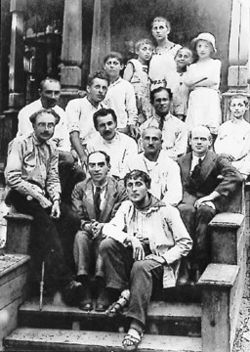- Der Nister
-
Der Nister (Yiddish: דער נסתּר; Berdychiv, Ukraine in 1884 – 1950 the Soviet Gulag) was the penname of Pinchus Kahanovich (פנחס כהנאָוויטש), a Yiddish author, philosopher, translator, and critic. Israel Joshua Singer, another famous Yiddish novelist, once said of Der Nister that "had writers of the whole world been given a chance to read [his] work, they would have broken their pens.”[1]
Contents
Biography
Kahanovich was born in Berdychiv to a Hasidic family of merchants. He received a traditional religious education, but was drawn through his reading to secular and Enlightenment ideas, as well as to Zionism. Forced to avoid the military draft to the Imperial Russian Army, he hid in Zhytomyr, where he earned a modest living as a tutor at an orphanage for Jewish boys. Even in his earliest works, he was drawn to the arcane teachings of the Kabbalah and to the intense use of symbols in his writings. This is reflected in the pseudonym he adopted, ‘’Der Nister" (in English, “The Hidden One”). His best-known work, Di Mishpokhe Mashber, is a more naturalistic family saga. It has been translated into English by Leonard Wolf as The Family Mashber. David Roskies calls the depiction of the protagonist, Moyshe, "the most finely wrought portrait of a hasidic merchant in all of Yiddish literature."[2] As in the novel, whose protagonist's brother joins the Breslover Hasidim, Pinchas's brother Aaron did the same. Der Nister himself was influenced Rebbe Nachman's Hasidic parables; though this manifests in his fiction, argues David Roskies, through a filter of Russian modernism, and authors like Andrei Bely also influenced his work.[3]
In 1920 he lived with Marc Chagall in Malakhovka.[4] In 1921, in the wake of the Russian Revolution, Der Nister left Russia and settled in Germany. While living in Berlin, he published his first two collections of stories. There, he also edited, along with David Bergelson, several Yiddish literary journals, though they didn't last long. In 1927, he returned to the Soviet Union, where his symbol-laden work, rich in Jewish themes, was declared reactionary by the Soviet regime and its literary critics. As a result, he stopped publishing his original works and earned a living as a journalist.
During World War II, the Soviet government briefly adopted less censorious policies over writings considered to be promoting Jewish nationalism. Der Nister began writing again, describing the persecution and destruction of the Jewish communities in Europe under the Nazi regime, and hinting at Soviet persecution as well, collected in his last writings, Viderverks. He was arrested in 1949 and sent to a prison camp, where he became ill and died the following year. Many of his contemporaries would later be killed in the Night of the Murdered Poets.
Der Nister appears as one of the main characters in the novel The World to Come (2006) by Dara Horn. The book describes Kahanovich's uneasy friendship with artist Marc Chagall, inside whose frames he hid some of his writings. Adaptations, descriptions, and excerpts from his stories, and those of other Yiddish writers, are included. (Horn makes one fictional change: Der Nister dies almost as soon as arrested, whereas in reality he died the following year, or maybe as late as 1952 according to some sources).
Works (selected)
- Gedankn un motivn - lider in prose ("Ideas and Motifs - Prose Poems"), Wilna, 1907
- Hecher fun der Erd ("Höher von der Erde"; "Higher than the Earth"), Warsaw, 1910
- Gesang un gebet, Kiev 1912 (collection of songs)
- Translation of selected tales from Hans Christian Andersen, 1918
- Meiselech in fersn ("Erzählungen in Versen"; "Stories in Verse"), 1918/19 (many editions: Kiev, Warsaw, Berlin)
- Gedacht ("Imagined"), Berlin, 1922/23 (collection of fantastic stories, 2 vols.)
- Fun meine giter("From My Estates"), Kiev 1929
- Hoiptstet, Moscow, 1934
- Sechs meiselech ("Six Little Tales"), 1939
- Di mischpoche Maschber, Kiev, 1939 (Vol. 1), New York, 1948 (Vol. 2)
- Khurbones ("Victims"), Moscow, 1943
- Dertseylung und eseyen ("Stories and Essays"), New York 1957 (posthumous)
- Widerwuks ("Regeneration"), Moscow, 1969 (posthumous)
References
- ^ Mitchell, Elizabeth. "Toward the Abyss". Tablet Magazine. http://www.tabletmag.com/arts-and-culture/books/982/toward-the-abyss/. Retrieved 16 June 2011.
- ^ Roskies, David, A Bridge of Longing, 218
- ^ Roskies, David, A Bridge of Longing, page 195.
- ^ Dara Horn, The World to Come, New York: W. W. Norton, 2006, p. 313.
External links
- Der Nister and his symbolist short stories (1913-1929): Patterns of imagination by Daniela Mantovan, Columbia University (1993)
- Der Nister in The YIVO Encyclopedia of Jews in Eastern Europe
- "Der Nister". Jewish Encyclopedia. http://www.berdichev.org/der_nister_1.html.
Categories:- 1884 births
- 1950 deaths
- People from Berdychiv
- Ukrainian Jews
- Jewish writers
- Yiddish-language writers
- Translators to Yiddish
- Soviet Jews
Wikimedia Foundation. 2010.

